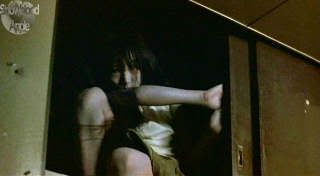In this section I will be underlining the codes and convention I have identified in Japanese and American directed horror films
Why?
To prevent confusion between characteristics and codes & conventions and to make a comparison between Eastern and Western directing styles.
Codes:
Definition/meaning:
Codes are systems of signs, which create meaning. Codes can be divided into two categories – technical and symbolic. Some codes fit both categories – music for example, is both technical and symbolic.
Symbolic codes show what is beneath the surface of what we see. For example, a character's actions show you how the character is feeling.
Technical codes are all the ways in which equipment is used to tell the story in a media text, for example the camera work in a film.
Codes in American directed horror films:
(which I have identified)
Symbolic:
Weapons:
'A majority of horror films involve the use of weapons, from machine guns to saws. Weapons have phallic symbolism that suggests masculine power and the woman that outsmarts the villain essentially castrates him. Leatherface’s weapon in the Texas Chainsaw Massacre (1974) is the ultimate phallic symbol of raging power. The type of weapons a writer chooses for his or her villain – knife, gun, sword, club, saw –is most powerful when it reflects character; Leatherface lives on and on for this very reason.'
(http://constructinghorror.com/index.php?id=123)
Examples:
A Nightmare on Elm Street (1984), The Texas Chainsaw Massacre (1974) and Friday the 13th (1980)
Technical:
 |
| http://nzfilmfreak.files.wordpress.com/2013/02/blair-witch-project-heather-donahuejpg-cc43367e7ecdc67d.jpg |
‘POV horror is easy and cheap to make and has proven time and again to go viral in advertising and turn a profit quickly because of the low costs.’
(http://thesketchydetails.net/archives/721)
Examples:
Paranormal Activity (2007), Quarantine (2008) and The Blair Witch Project (1999)
Codes in Japanese directed horror films
(which I have identified)
Symbolic:
 |
| http://www.dvdtimes.co.uk/protectedimage.php?image=ColinPolonowski/grudge5.jpg |
'Death is naturally pervasive in horror films and there are countless representative objects, such as coffins, gravestones, skeletons, angels of death, and so forth.'
(http://constructinghorror.com/index.php?id=123)
Examples:
Ju-on: The Grudge (2002), Chakushin Ari (2002) and Ringu (1998)
Technical:
 |
| http://i77.photobucket.com/albums/j46/hannahmfan101/chakushinaricupboard.jpg |
‘High contrast lighting is dominated by harsh lines of light combined with dramatic streaks of blackness. This lighting style tends to use shadows and can look haunting and eerie when it is used well. As a sign, high contrast lighting suggests a sense of anxiety or confusion. It can also be used to suggest a corrupt world which haunts and threatens the characters on screen.’
(http://inpoint.cinematheque.bc.ca/pdf/LanguageofFilm08.pdf)
Examples:
Ju-on: The Grudge (2002), Chakushin Ari (2002) and Ringu (1998)
Conventions:
Conventions are the generally accepted ways of doing something. There are general conventions in any medium, such as the use of interviewee quotes in a print article, but conventions are also genre specific.
Conventions in American directed horror films:
(which I have identified)The Final Girl:
‘A term coined by the awesome Carolyn J. Clover, the Final Girl is the one at the end - dirty, covered in blood, about to spend a mint on therapy, but victorious - the one who lives to tell the tale.’
(http://www.allthingshorroronline.net/2013/03/slicing-through-final-girl-fantasies.html)
Examples:
The Texas Chainsaw Massacre (2003), Halloween (1978) and I Know What You Did Last Summer (1997)
Conventions in Japanese directed horror films:
(which I have identified)
 |
| http://whatculture.com/wp-content/uploads/2011/10/darkwater3.jpg |
'Ghosts are particularly common - everyone is believed to go to a limboish place after death, for seven years. They move on through the prayers and rituals of their ancestors, so a lack of filial piety is one reason for troublesome spirits, but the main cause is a lack of calm at death, particularly violent emotions leading to especially potent ghosts. Clearly these are two reasons rich in narrative possibility. Revenge is of course the most common desire for restless spirits.'
(http://www.japanese-arts.net/themes/horror.htm)
Examples:
Ju-on: The Grudge (2002), Chakushin Ari (2002), Ringu (1998) and Dark Water (2002)
What relevance does this research provide towards the development of my project?
To identify the unique characteristics of Japanese horror, one must first look at the codes and conventions of horror, not only in Japanese horror but in American horror too. Doing so can aid in the identification of the characteristics of Japanese horror in the medium of film.
Resources
(http://media-studies.tki.org.nz/Teaching-media-studies/Media-concepts/Codes-and-conventions) - codes and conventions


No comments:
Post a Comment